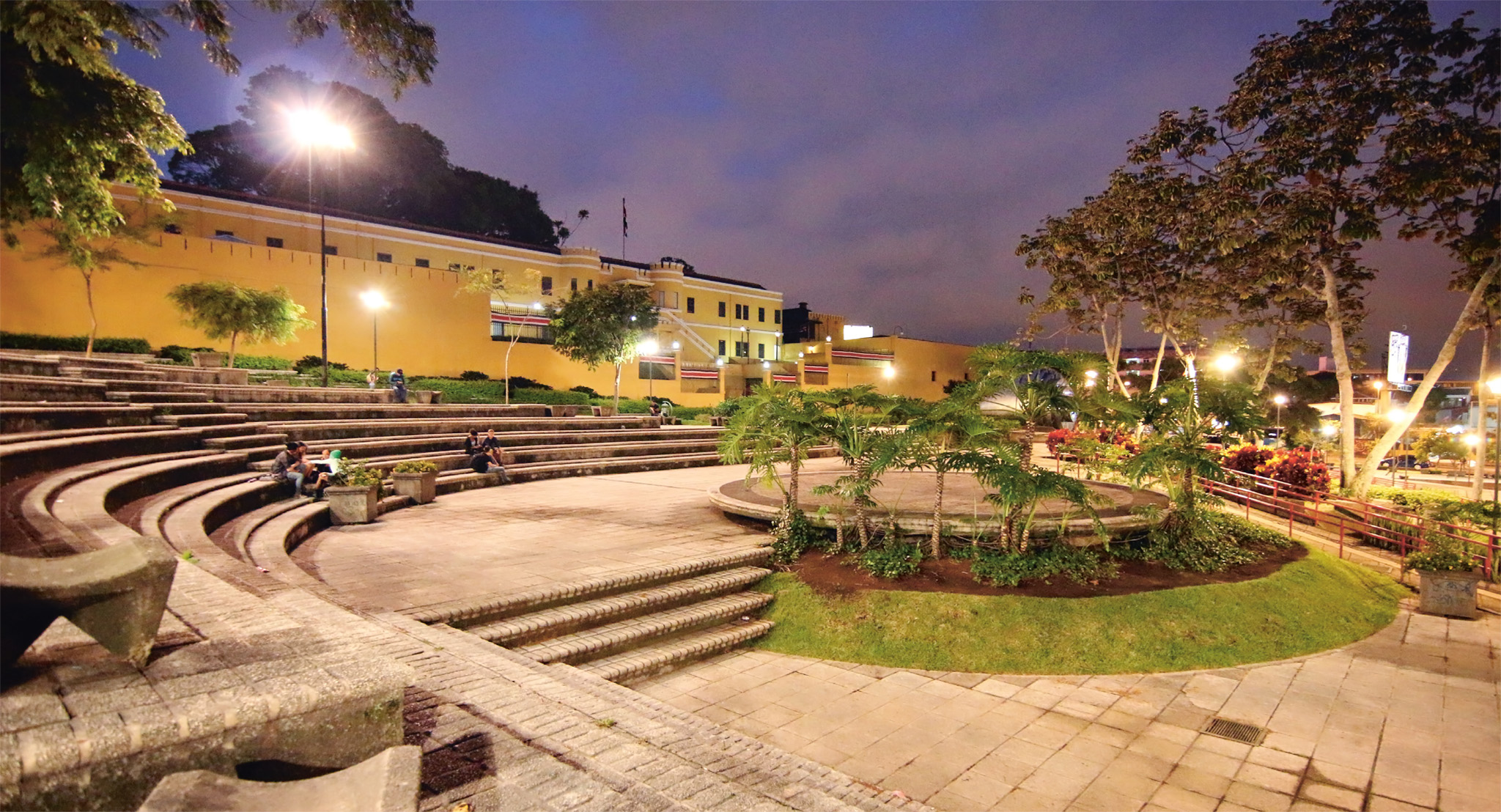Experience More
San José’s pre-eminent church, the Metropolitan Cathedral was built in 1871 to replace the original cathedral, which had been destroyed by an earthquake in 1820. Designed by Eusebio Rodríguez, the austere-looking structure combines Greek Orthodox, Neo-Classical, and Baroque styles. Its linear façade is supported by an arcade of Doric columns and topped by a Neo-Classical pediment with steeples on each side. Inside, a vaulted ceiling runs the length of the nave, supported by two rows of fluted columns. In a glass case to the left of the entrance is a life-size statue of Christ.
Although entirely lacking the ornate Baroque gilt of many other Latin American churches, the cathedral has many fine features, notably an exquisite colonial-style tiled floor and beautiful stained-glass windows depicting biblical scenes. The main altar, beneath a cupola, comprises a simple wooden base atop a marble plinth and supports a wooden figure of Christ and cherubs.
To the left of the main altar is the Capilla del Santísimo (Chapel of the Holy Sacrament), with flower-painted wooden quadrants decorating the walls and ceilings. The short gallery that leads to the chapel contains a glass-and-gilt coffin with a naked statue of Christ draped with a sash in the red, white, and blue of the Costa Rican flag.
To the south of the cathedral is La Curía (The Palace of the Archbishop), built in 1887. This two-story structure, which has been remodeled, is closed to the public. A small garden in front features a life-size bronze statue of Monseñor Bernardo Augusto Thiel Hoffman (1850–1901), the German-born second archbishop of Costa Rica. Hoffman lies buried in the crypt of the cathedral, alongside former president Tomás Guardia.
On the cathedral’s north side is a contemporary marble statue of Pope John Paul II by Jiménez Deredia.
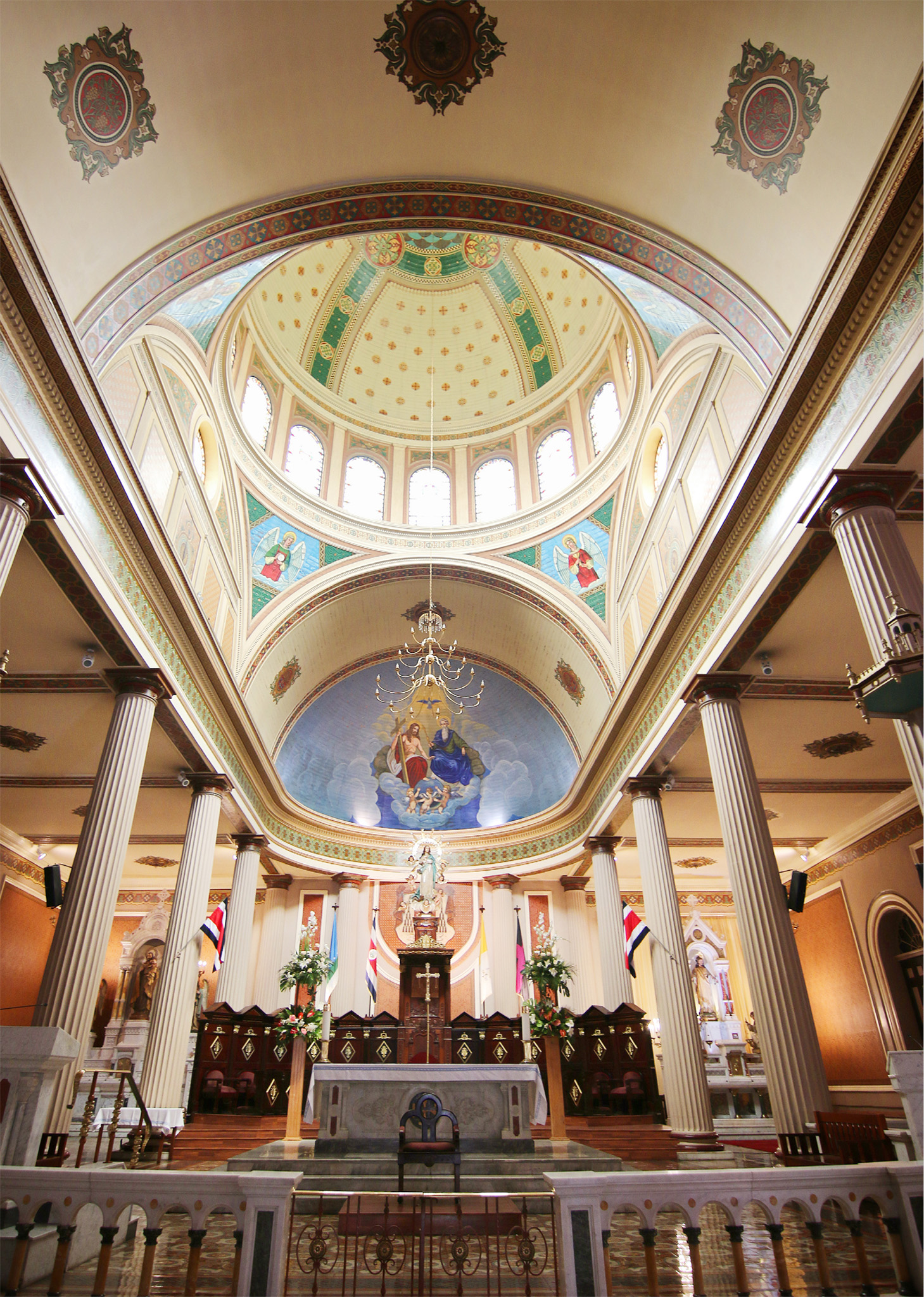
t The simple columns and decoration of the Metropolitan Cathedral
Did You Know?
Locals colloquially refer to San José as “Chepe” – the nickname for anyone named José.
An intriguing curiosity, San José’s Central Market was built in 1881. The building, which takes up an entire block northwest of the Catedral Metropolitana, is itself rather uninspiring, but its warren of narrow alleyways, hemmed in by more than 200 stalls, immerse visitors in a slice of Costa Rican life. This quintessential Latin American market thrives as a chaotic emporium of the exotic. Every conceivable item is for sale here, from herbal remedies and fresh-cut flowers to snakeskin boots and saddles for sabaneros (cowboys). Toward the center, sodas (food stalls) offer inexpensive cooked meals sold at the counter. The market extends one block north to Mercado Borbón, which has stalls of butchers, fruit sellers, fishmongers, with buyers crowded into the aisles looking for a bargain. Next to the market’s entrance on the southeast corner, the wall is lined with plaques that honor the country's important political figures.
Pickpockets are known to operate within the tightly packed alleys of the market, so it is best to leave your valuables in your hotel safe when visiting, and to keep phones and cameras out of sight when not in use.
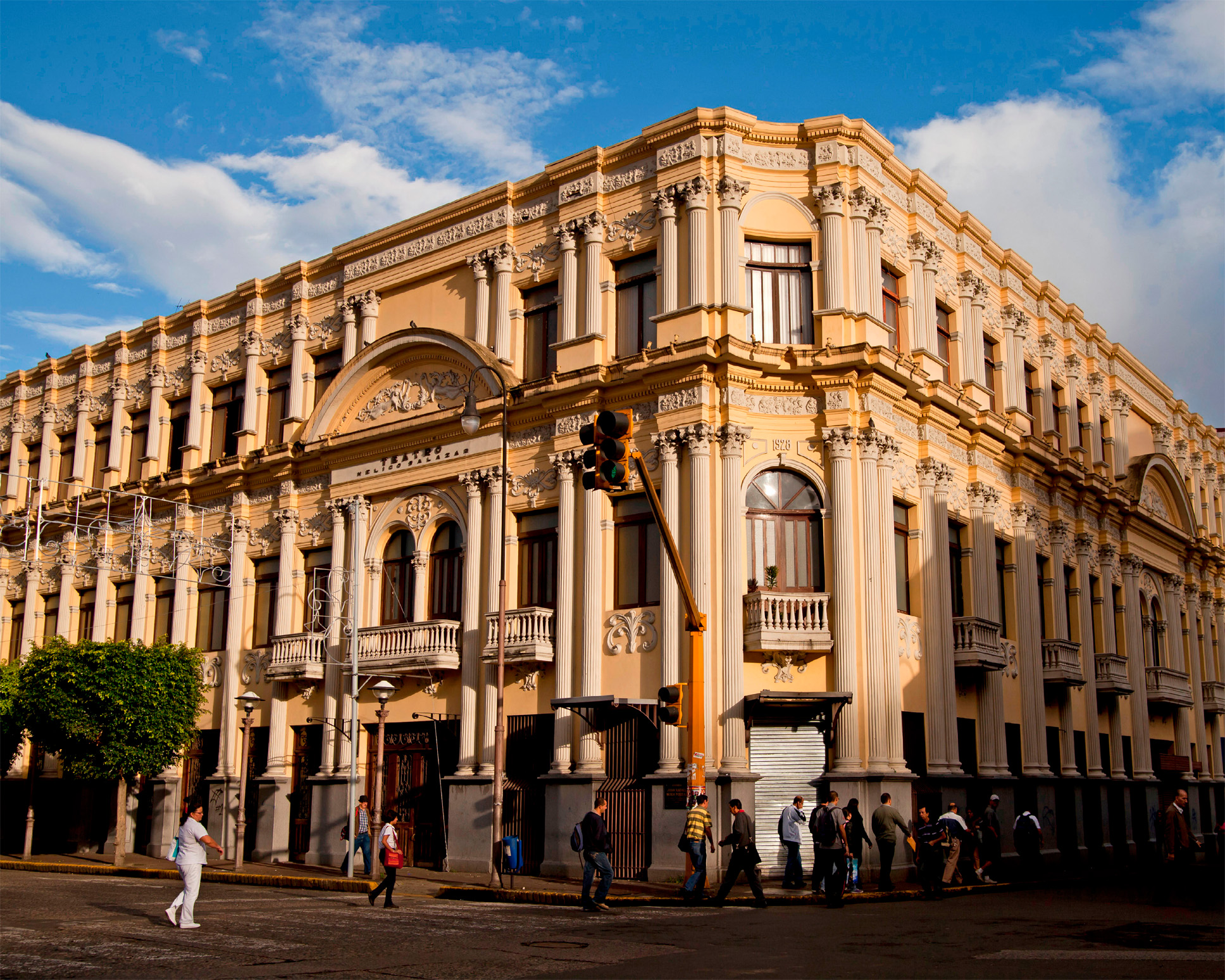
t The Teatro Mélico Salazar, a “Specialist Cultural Institution” of the Costa Rican state
One of the city’s landmarks, this theater was built in 1928 as the Teatro Raventós, and was a venue for zarzuelas – light, often comic Spanish operettas. After a spell as a movie theater in the 1960s it was damaged by fire but was restored and reopened in 1986, and renamed in honor of Manuel “Mélico” Salazar Zúñiga (1887–1950), a celebrated Costa Rican tenor. Designed by architect José Fabio Garnier, it has a Neo-Classical façade adorned with fluted Corinthian pilasters. To the left of the entrance is a larger-than-life bronze bust of Zúñiga. To the right is a bas-relief plaque honoring José Raventós Gual, who had the theater built.
The handsome lobby, in checkered green-and-black tile, leads into a triple-tiered, horseshoe-shaped auditorium, where theatrical and musical events, as well as folk dance shows are staged. The auditorium has a striking parquet wooden floor and a soaring wood-paneled ceiling, decorated with a simple mural and a wrought-iron chandelier.
EXPERIENCE San José
|
Shop Chietón Morén Specializing in quality arts and crafts, this “fair deal” store represents Costa Rica’s indigenous communities. E4 ⌂ Calle 17 and Aves 2/6 ∑ chietonmoren.org Galería Namú Known for its Boruca masks, Galería Namú also sells locally made baskets, hammocks, jewelry, and folk art by contemporary artists. D3 ⌂ Calles 5/7 and Ave 7 ∑ galerianamu.com Mercado de Artesanías Nacionales This is the principal market in San José for all manner of artisanal crafts, and it has dozens of stalls selling a miscellany of goods, from carvings to cowboy boots. D4 ⌂ Plaza Artigas, Calle 11 and Aves 4/6 |
Laid out in 1881, this small park was later renamed after Francisco Morazán, the Honduran-born Central American federalist who served briefly as president of Costa Rica before being executed in 1842. Shaded by tabebuia trees that bloom in the dry season, the park is popular with locals, and hosts a cultural fair every Saturday, as well as occasional concerts.
The park’s four ornate iron gateways are topped by Roman urns. At its center is the domed Neo-Classical Templo de Música, built in 1920. Busts honor Morazán and other luminaries such as South American liberator Simón Bolívar (1783–1830).

t The bandstand in Parque Morazán, popular with office workers, schoolchildren, and lovers

Insider Tip
Walk This Way
Barrio Bird Walking Tours (toursanjosecostarica.com) offers themed tours through different neighborhoods, led by local artists, entrepreneurs, and others dedicated to downtown revitalization. The “Bird’s Nest Tour” offers an overview, but other specialty themes include art, cuisine, and coffee; a “Saturday Favorites” tour combines all three.
Constructed entirely using prefabricated pieces of metal, this intriguing structure, which stands between the Parque Morazán and Parque España, was designed by French architect Charles Thirio. The metal pieces were cast in Belgium in 1892 and shipped to Costa Rica to be assembled, jigsaw-like, in situ. Since then, it has functioned as a local elementary school. A small bust of Minerva, the Roman goddess of wisdom, sits on top of its imposing Neo-Classical façade. An elaborate fountain in the small plaza in front of the school provides an appealing photo opportunity.
Shaded by densely packed trees and bamboo groves, this leafy plaza is pleasantly full of birdsong. It was here, in 1903, that the Costa Rican national anthem, written by José María Zeledón Brenes (1877–1949) and Manuel María Guttierez (1829–87), was first performed.
On the northeast corner, a quaint Colonial-style pabellón (pavilion), erected in 1947, is inlaid with sepia-toned ceramic murals of the apparition of the Lady of Los Angeles, the church of Orosí, and the cathedral of Heredia. A patinated life-size statue of conquistador Juan Vásquez de Coronado stands at the southwest corner of the park. Brick pathways wind past busts of figures, including Isabel II of Spain (1830–1904) and philanthropist Andrew Carnegie (1835–1919).
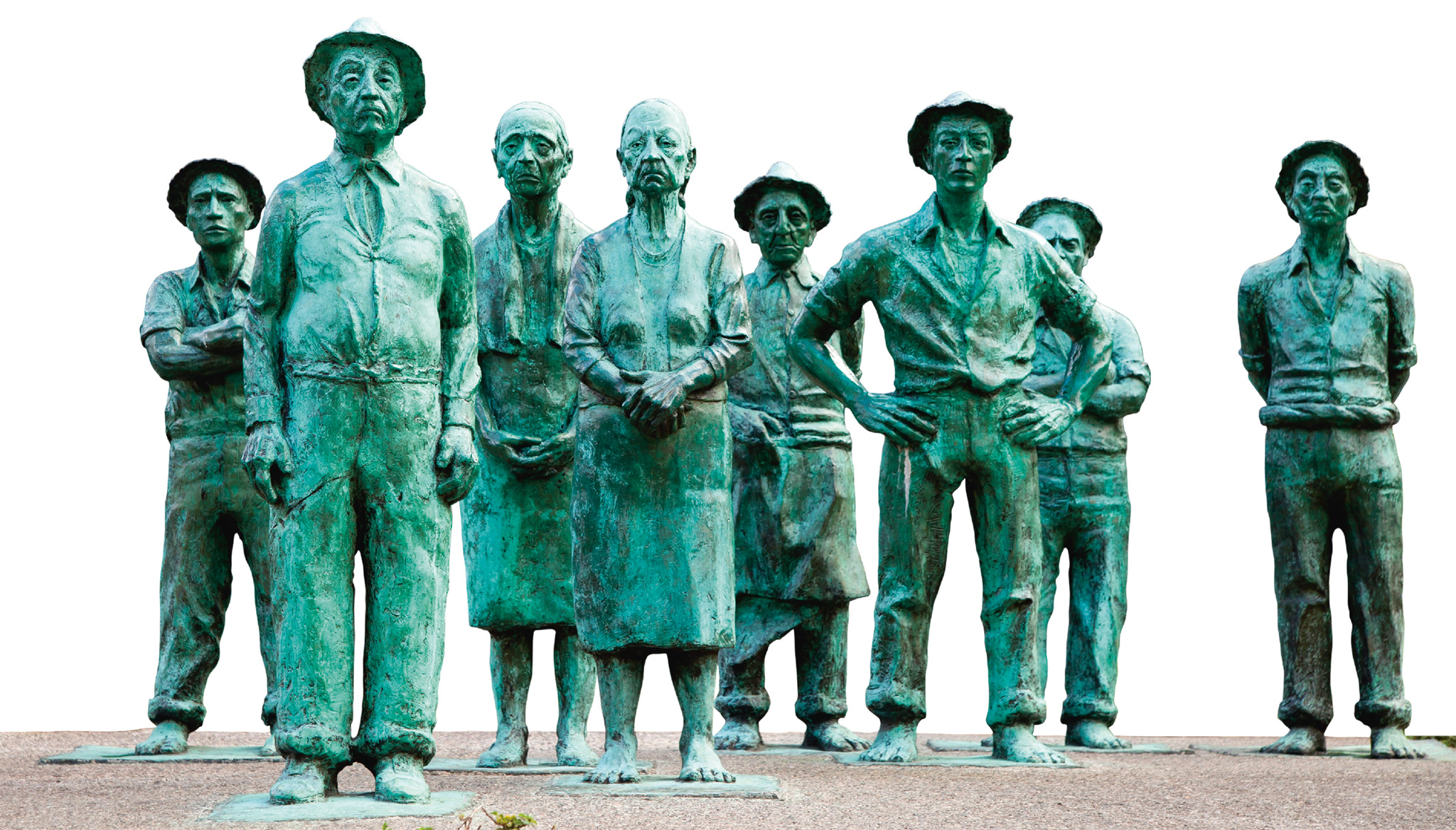
t Los Presentes, created in 1979 by well-known sculptor Fernando Calvo
The building housing the main post office, or Correo Central, was completed in 1917. It was designed by Luis Llach in eclectic style, with Corinthian pilasters embellishing its concrete façade. The arched centerpiece is topped by a shield and supported by angels bearing the national coat of arms. The post office buzzes with the comings and goings of locals picking up their mail at the apartados (post office boxes) that fill the ground floor of the atrium.
Philatelists can view rare stamps in the small Museo Filatélico de Costa Rica (Philatelic Museum of Costa Rica), which occupies six airy rooms on the upper floor. In the first, a range of Costa Rican stamps are offered for sale, and the second has a fine collection of old telephones and telegraphic equipment that goes back more than 100 years. The collection of stamps occupies the other four rooms, which also have exhibits on the history of philately in Costa Rica. The nation’s first stamp, from 1863, is displayed here. There are also important and rare stamps from abroad, including the British Penny Black. The entrance fee entitles you to one stamped postcard to send anywhere in the world.
The Edificio Correos is fronted by a pedestrian plaza dominated by a statue of the first president of Costa Rica, Juan Mora Fernández, who was in power from 1824 to 1833. Southwest of the Edificio Correos is another square, Plaza Los Presentes, which forms the setting for sculptor Fernando Calvo’s Los Presentes, a contemporary monument in bronze to Costa Rican campesinos (peasant farmers). The square is the place to go if you want to look your best: shoeshines still ply their trade in the leafy plaza.
"
Museo Filatélico de Costa Rica
§ 2223-6918 # 8:15–11:30am & 1:15–4:30pm Mon-Fri; 8–11:30am last Sat of month ¢ Public hols
The richest collection of San José’s historic homes populate this residential barrio (neighborhood), which was founded in the 1890s. The most interesting are along Avenida 9; the stretch between Calles 3 and 7 is lined with beautiful ceramic murals showing traditional Costa Rican scenes, created by Fernando Matamoros.
At Calle 11, No 980 is a two-story colonial mansion; gazing over its railings is a life-size campesino. At Calle 9, the Hotel Don Carlos was once the residence of President Tomás Guardia. One block west, at the corner of Calle 7, is Casa Verde, a clapboard building of New Orleans pine dating to 1910. The most audacious building is the Bishop’s Castle at Avenida 11 and Calle 3. Built in 1930 in ornate Moorish style, it features keyhole windows, a central dome, and glazed tiles showing scenes from the novel Don Quixote.
EXPERIENCE San José
|
Eat Kalú Fresh seasonal dishes served in an airy and modish restaurant. B5 ⌂ Calle 31 and Ave 5 ∑ kalu.co.cr \ La Esquina de Buenos Aires Bohemian vibes and gourmet cuisine. D4 ⌂ Calle 11 and Ave 6 ∑ laesquinadebuenosaires.net \ Saga Chic décor and French-inspired fusion fare. A5 ⌂ Ave Escazú ∑ avenidaescazu.com/en/_gastronomia/saga \ Product-C Fresh sustainable seafood at its best. A5 ⌂ Ave Escazú \ |
Dramatic and imposing, the crenellated, ocher-colored Bellavista Fortress – opposite the Legislative Assembly – was built in 1917 and served as an army barracks. Its exterior walls, with towers at each corner, are pocked with bullet holes from the 1948 civil war. Following his victory, José “Don Pepe” Figueres disbanded the army, and the fortress became the venue for the National Museum, which had been founded in 1887. The entrance, on the west side, opens to a large netted butterfly garden with a snaking walkway that leads up to a landscaped courtyard displaying pre-Columbian carretas (oxcarts), stone bolas (spheres), and colonial-era cannons. The museum is arranged thematically in a counterclockwise direction around the plaza. Rooms are dedicated to geological, colonial, archaeological, contemporary, and religious history, from the first arrival of humans in Costa Rica to the formation of the nation and recent events. The museum has a particularly impressive pre-Columbian collection, notably of metates (grinding stones) and ceramics, as well as spectacular gold ornaments displayed in the Sala de Oro, in the northeast tower. The Sala Colonial, laid out with rustic colonial furniture, is presented as a typical room would have looked in the 18th century.
The museum is approached via steps from the Plaza de la Democracia, laid out in 1989 to commemorate 100 years of Costa Rican democracy. The stepped plaza hosts a 1994 bronze statue of José Figueres; the Cubist Museo de Jade Fidel Tristán Castro rises on the northwest side.
Did You Know?
Instead of street addresses, locals use distances from landmarks – many defunct – as locators.
Experience San José
Jade Carving

t FROG PENDANT
Jade carving was introduced to the region by cultures from the north around 500 BC and died out around AD 800, when gold replaced the stone as the material of choice. Saws made of fiber string, as well as drills and crude quartz-tipped chisels were used to carve the stone into necklaces, pendants, and religious figurines bearing replicas of animal motifs.
Located in a stunning black Cubist monolith on the western side of Plaza de la Democracia, this magnificent museum contains the largest collection of pre-Columbian jade pieces in the Americas. It was founded by Fidel Tristán Castro, the first president of the INS, in 1977. The collection consists of adzes (cutting tools), ceremonial heads, and decorative items dating from 500 BC to AD 800. The collection also includes metates made of volcanic stone, ceramics, and gold ornaments. The Sala de Jade displays pendants in kaleidoscopic hues of green and blue, exquisitely backlit to demonstrate their translucent quality. The jade pieces in this collection did not come from archaeological sites – they were purchased from private collectors who, somewhat controversially, had bought them from looters. The collection is displayed in six themed rooms and includes cultural events, workshops, film screenings, audio guides, and a cafeteria.

t Pre-Columbian ceramics from the Guanacaste region at Museo Nacional
Immediately east of Parque España, the rambling structure of the National Center of Culture (CENAC) takes up a block on the site of the former Fábrica National de Licores (State Liquor Factory); traces of the old distillery can still be seen. The Ministry of Culture is located here, as are venues hosting the National Theater Company and the National Dance Company. Most of the extant buildings date to 1856, as does the perimeter wall, whose stone west gate is topped by a triangular pediment. Note the reloj de sol (sun clock), carved into the perimeter wall to the right of the southeast portalón (gate) by architect Teodorico Quirós. The Museo de Arte y Diseño Contemporáneo (Museum of Contemporary Art and Design) occupies the southeast part of the complex and features exhibitions of art, architecture, and ceramics. Evelia con Baton, a sculpture by Costa-Rican-born Francisco Zúñiga, stands in the west courtyard.
Museo de Arte y Diseño Contemporáneo
# 9:30am–5pm Tue–Sat ¢ Public hols ∑ madc.cr
Costa Rica’s seat of government is in an enclave of four buildings, covering an entire block. The main structure, the Edificio del Plenario, built in 1958, serves as the congress building. A bronze statue of national hero Juan Santamaría, torch in hand, stands in the north courtyard. The pink Casa Rosada, to the northeast, houses the offices of various political parties. The pretty blue Castillo Azul to the southeast was built in 1911 for Máximo Fernández, then a presidential aspirant.
The buildings can only be visited by guided tour. Visitors are also admitted into the Edificio del Plenario to witness legislative debates on weekdays. When in the building, sandals are not permitted for men, nor are bare legs for either sex.
A 17-story building is being constructed on an adjacent block and will become the Asamblea’s main building; some of the current buildings will also be remodelled.

Insider Tip
Get Arty
Twice a month, themed evening Art City Tours are sponsored by the GAM Cultural Guide (www.gamcultural.com). Parks, galleries, and other venues host free artistic events and museums offer free admission. A free electric trolley carries visitors between the venues.
Laid out in 1895, the largest of San José’s inner-city parks is also its most appealing. The peaceful park sprawls across a gentle hill that rises eastward. Stone benches fringe the irregular paths that snake beneath flowering trees, swaying palms, and breezy bamboo groves. The massive Monumento Nacional is at the center, cast in the Rodin studios in Paris. Unveiled on September 15, 1892, it is dedicated to the heroic deeds of the War of 1856. Upon its granite pedestal are five bronze Amazons representing the Central American nations as they repelled adventurer William Walker. Costa Rica stands in the middle, holding a flag in one hand and supporting a wounded Nicaragua with the other; El Salvador holds a sword, Guatemala an axe, and Honduras an arch and shield. Bronze bas-reliefs to each side depict scenes from the different battles. Busts dotted around the park honor Latin American heroes including the Mexican revolutionary and priest Miguel Hidalgo (1753–1811), the Venezuelan poet and intellectual Don Andrés Bello (1781–1865), and the Cuban patriot and poet José Martí (1853–95).
The park is surrounded by important buildings. The Biblioteca Nacional (National Library) is to the north, and to the south, the Bulevar Ricardo Jiménez, named for the three-time president, runs down three blocks to the building of the Tribunal of Justice.
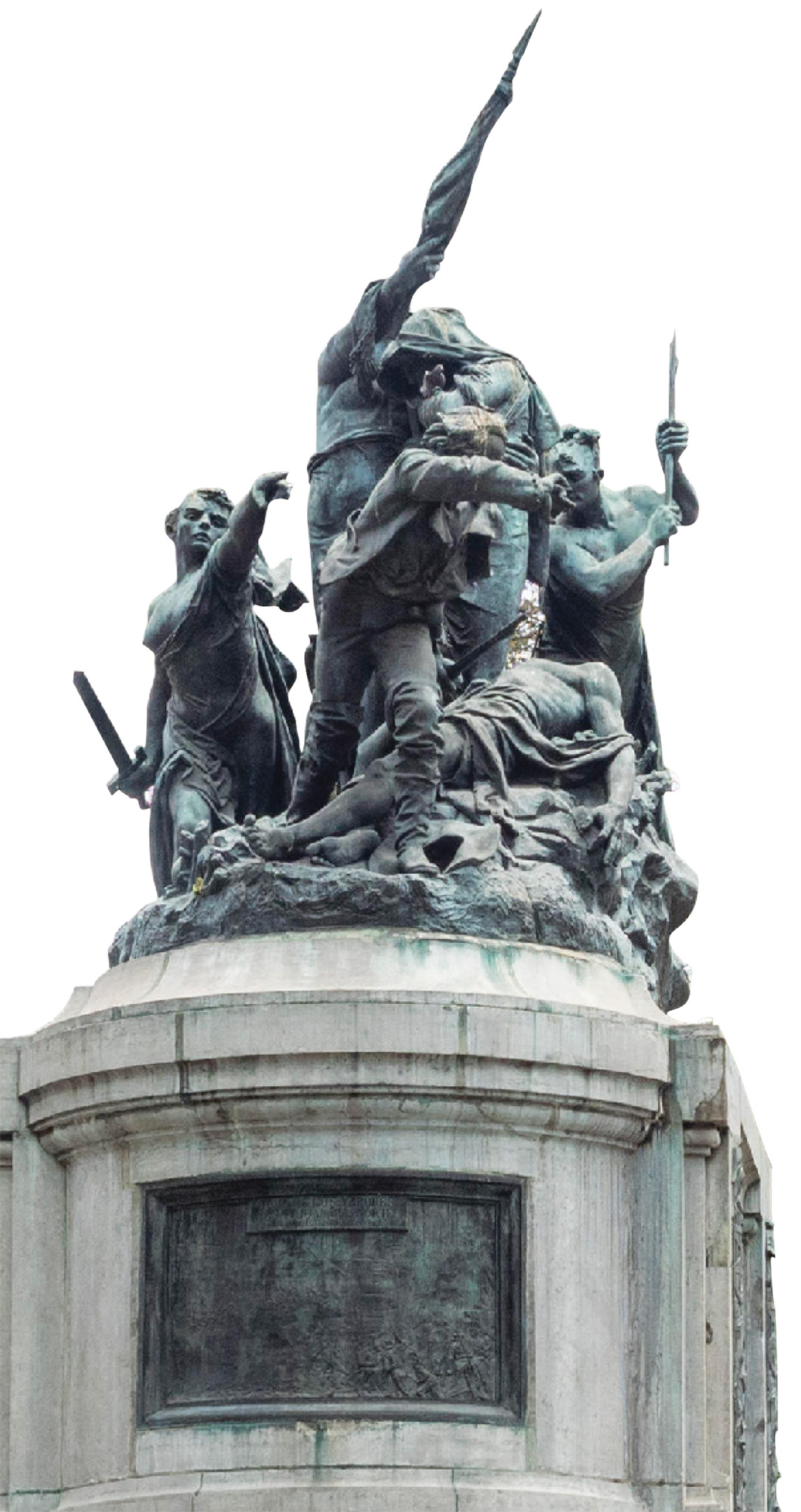
t A group of heroic Amazons forming the Monumento Nacional
To the northeast of the Parque Nacional is the former Estación Ferrocarril al Atlántico (Atlantic Railroad Station). Built in 1908, this ornate French Beaux-Arts-style building, which resembles a pagoda, later became the terminus for the famous “Jungle Train,” discontinued in 1991 following a devastating earthquake that destroyed much of the rail line. The building served as a museum for many years before being resurrected as a functioning station for the Tren Interurbano. Rail history buffs can appreciate the vintage rolling stock to the rear and east of the building. This includes Locomotora 59, a 1939 steam locomotive imported from Philadelphia for the Northern Railway Company.
A bust of General Tomás Guardia, under whom the railroad was established between 1871 and 1890, stands in front of the building, next to an obelisk commemorating the abolition of capital punishment in 1877.
The University of Costa Rica imbues the suburb of San Pedro with bohemian life. The campus entrance is on Calle Central (off Avenida Central), which throbs with student bars and cafés. The campus itself is not particularly appealing, although many busts and statues are sprinkled about the tree-shaded grounds, and a botanical garden is in the southwest corner.
The Museo de Insectos, which opened in 1962, is located in the basement of the Music Department in the northeast corner of the campus. It boasts large displays of butterflies, beetles, and other insects numbering almost a million. Visitors can call ahead to book edible-insect-tasting sessions. Finally, Planetario, a planetarium in the campus’s Ciudad de la Investigación, explores the rich biodiversity of Costa Rica.
Museo de Insectos
§ 2511-5318 # 8am–12pm & 1–4:45pm Mon-Fri
Planetario
# 9–11:10am & 1–7pm Mon-Fri, 5–7pm Sat ∑ planetario.ucr.ac.cr
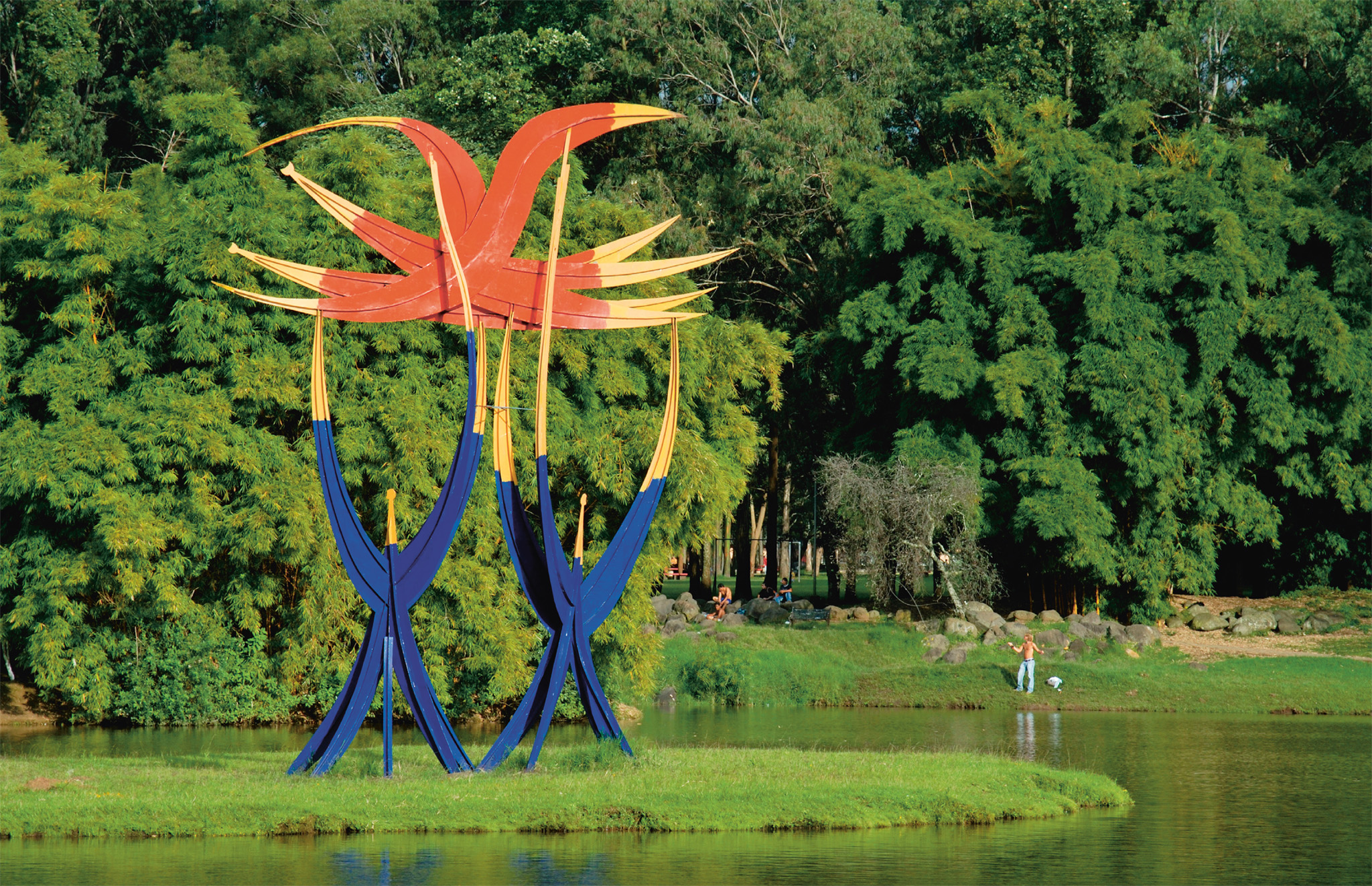
t Abstract figures towering above the lake in La Sabana Park
Officially named Parque Metropolitano La Sabana Padre Antonio Chapui, after the first priest of San José (1710–83), this park was the city’s main airfield until 1955, when it was converted into a bucolic retreat and sports venue. The former airport buildings now house the Museo de Arte Costarricense. Looming over the park are the curving ICE (Costa Rican Institute of Electricity) tower to the north, and the strangely sloping Controlaría de la República, the government’s administrative headquarters, to the south.
The park, accessed from downtown via the wide Paseo Colón, is popular with Costa Rican families, who picnic on weekends beneath the pine and eucalyptus groves. The park’s facilities include jogging and cycling tracks; basketball, volleyball, and tennis courts; riding trails; a swimming pool; a gymnasium, soccer fields; and the National Stadium, completed in 2011. There is also a rollerskating track at the east end of the park. On the south side, a man-made lake is surrounded by modern sculptures. To the west of the park, a cross honors Pope John Paul II’s visit to Costa Rica in 1983.
Did You Know?
Locals consider Parque Sabana to be the “lungs of San José”, akin to New York’s Central Park.
Experience San José
|
Stay Hotel Grano de Oro This elegant hotel is the city’s finest lodging and has a superb restaurant. B5 ⌂ Calle 30 and Aves 2/4 ∑ hotelgranodeoro.com \ Hotel Auténtico This stylish low-rise has chic décor and a handy location close to Parque Sabana. B5 ⌂ Calle 40 and Aves 5/7 ∑ autenticohotel.com \ Casa de las Tías An intimate, family-run colonial mansion turned B&B, set in the heart of Escazú. Gourmet breakfasts. A5 ⌂ San Rafael de Escazú ∑ casadelastias.com \ |
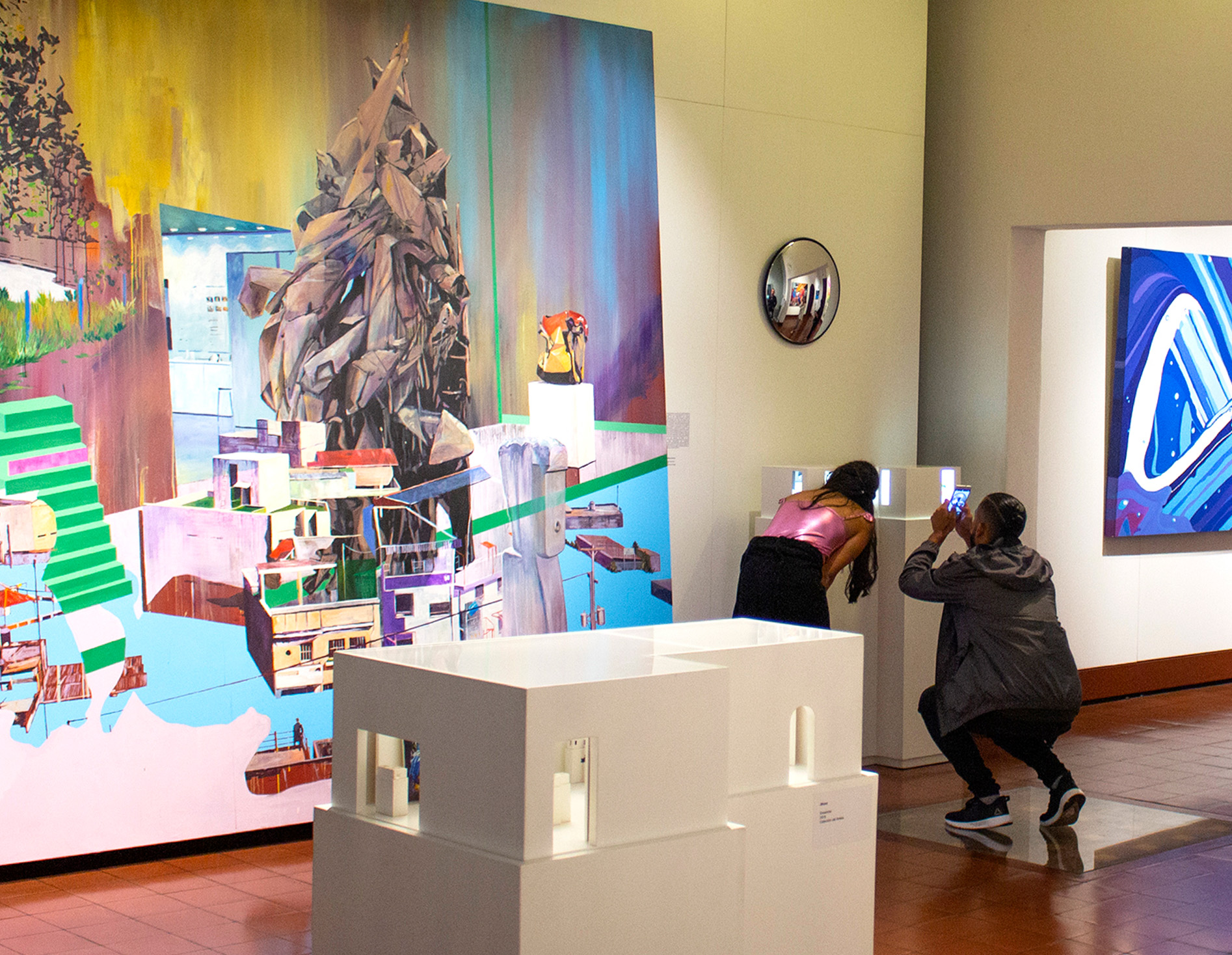
n Examining the art in a gallery room at the Museo de Arte Costarricense
Costa Rica’s leading museum of fine art, on the east side of Parque Sabana, is situated in the colonial-style former airport terminal that closed in the 1950s. The Costa Rican Art Museum displays more than 3,200 important 20th-century works of art by Costa Rican sculptors and painters, as well as a smattering of foreign artists, including Mexican Diego Rivera (1886–1957). Many of the works celebrate a romanticized, pastoral way of life, exemplified by El Portón Rojo (1945) by Teodorico Quirós Alvarado.
A highlight of the collection, and not to be missed, are Francisco Amighetti’s wooden sculptures and woodcuts. On the second floor, the Salón Dorado has a bas-relief mural in bronze and stucco by French sculptor Louis Ferrón. Sweeping around all four walls, the panorama depicts an idealized version of Costa Rican history from pre-Columbian times to the 1940s.
The Jardín de Esculturas (Sculpture Garden) at the rear exhibits works by prominent sculptors, and also displays pre-Columbian stone esferas (spheres) and petroglyphs. Most intriguing are the Tres Mujeres Caminando, Francisco Zúñiga’s sculpture of three women, and the granite Danaide, a female curled up in the fetal position, by Max Jiménez Huete.
This splendid park, in Barrio La Uruca, 2 miles (3 km) west of downtown, draws local families not only for the roller coasters, water slides, and other pay-as-you-go rides, but also for the marvelously done re-creations of scenes from early 20th-century Costa Rican life in the adjoining Pueblo Antiguo (Old Town).
Pueblo Antiguo is divided into three sections: the capital city, the countryside and the coast. Buildings in traditional architectural style include a church, a market, a bank, a fire station, and a railroad station. There are several original adobe structures, such as a coffee mill, a sugar mill, and a milking barn, which have been moved here from remote rural quarters and rebuilt in their entirety. A farmstead is stocked with live animals.
Kids will enjoy a ride around the village on the electric train, as well as the antics of actors in period costume who can be found all over the village dramatizing scenes from the past. Folkloric shows with music and dance bring the place to life on Friday and Saturday evenings. The park also has a number of craft shops as well as a restaurant that serves Costa Rican fare.
EXPERIENCE San José
|
Drink ChepeCletas This cultural group leads a nightly tour of San José cantinas. Tintos y Blancos Classy wine and tapas bar with live music. A5 ⌂ Centro Comercial Multiplaza ∑ tintosyblancos.com Stiefel A convivial pub in a historic building. D3 ⌂ Calles 13/15 and Ave 7 § 8850-2119 Bebedero Retro-styled cocktail bar in a cultural center. C4 ⌂ Calle 1 and Ave 1 ∑ www.edificiosteinvorth.com/bebedero |
This upscale district lies west of the Parque Sabana and is accessed by the Carretera Prospero Fernández. Its appeal is partly down to its blend of antiquity and modernity, and partly to its position at the foot of Cerro Escazú mountain. The suburb, which derives its name from the indigenous word itzkatzu (resting place), sprawls uphill for several miles. It is divided into three main barrios – San Rafael de Escazú, San Miguel de Escazú, and San Antonio de Escazú.
Everyday life bustles in congested San Rafael de Escazú, where an exquisite colonial-style church, Iglesia Jiménez y Tandi, designed in the 1930s by Costa Rican-born architect Teodorico Quirós Alvarado, is encircled by high-rise condominiums and US-style malls. Half a mile (1 km) uphill, in San Miguel de Escazú, colonial-era adobe houses are painted with a strip of blue. It is believed that this was done to ward off witches.
San Antonio de Escazú, farther uphill, is a farming community. Time your visit here for the second Sunday of March, when flower-bedecked carretas (oxcarts) parade during Día del Boyero (Oxcart Drivers’ Day), a festival held in honor of the men who drive the oxcarts. Barry Biesanz Woodworks is in the barrio of Bello Horizonte, in east Escazú. This is the workshop of Costa Rica’s leading woodcarver and craftsman, who creates elegantly beautiful furniture, bowls, and boxes from Costa Rica’s hardwoods. His works are available at the studio and at upscale San José stores.
' =
Barry Biesanz Woodworks
⌂ Barrio Bello Horizonte # May–Nov: 8am–5pm Mon–Fri; Dec–Apr: 8am–5pm Mon–Fri, 9am–3pm Sat ∑ biesanz.com
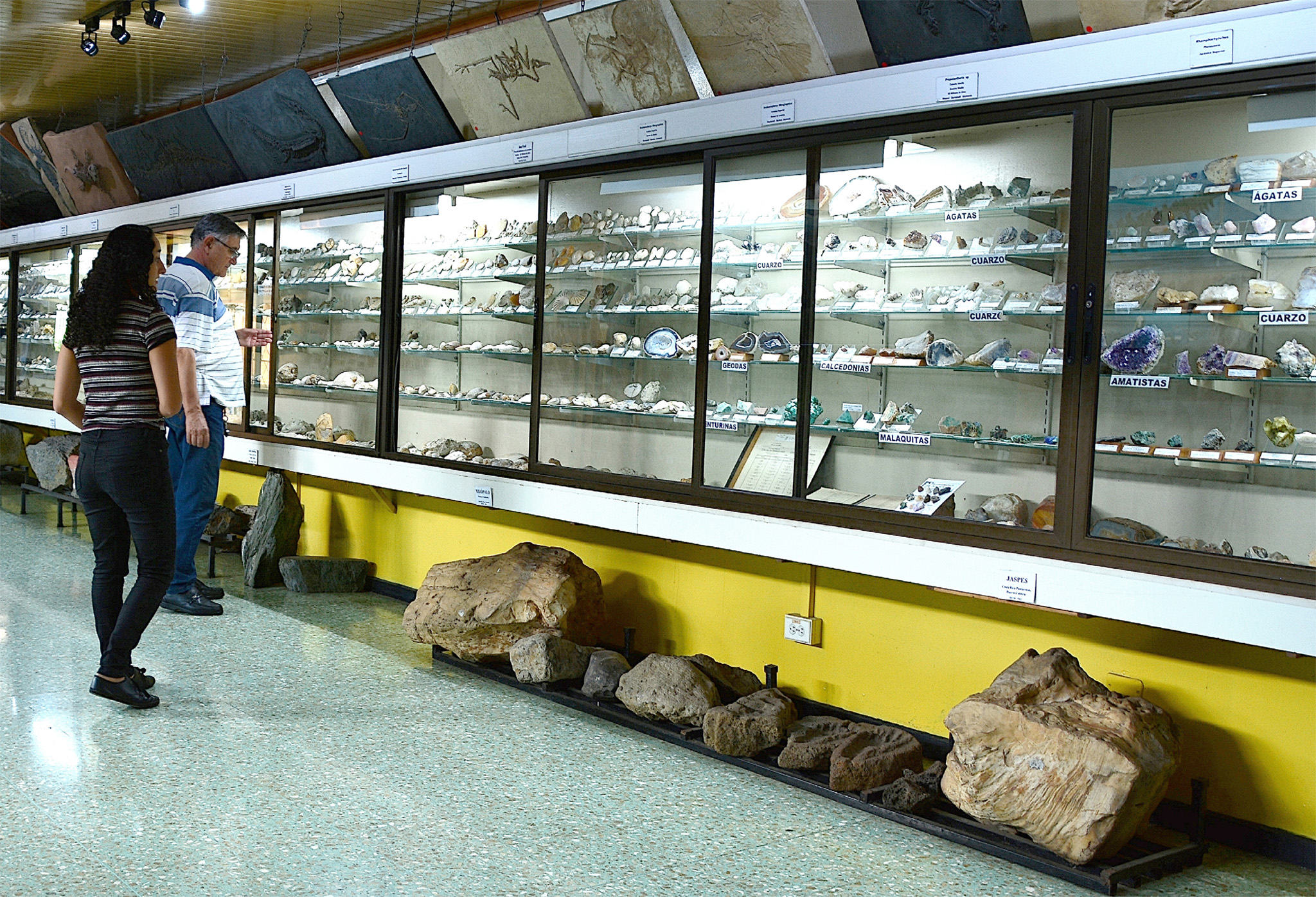
t Formal displays and eccentric dioramas
Located in the former Colegio La Salle school, La Salle Museum of Natural Sciences houses one of the most comprehensive collections of native and exotic flora and fauna in the world: more than 70,000 items, from molluscs to moths to manatees. The fossil, shell, and butterfly displays are particularly fine. Most exhibits are arranged in dioramas: snakes are poised to strike their prey, and fish swim suspended by invisible wire. The mounted specimens are a bit moth-eaten, and their contrived contortions often comic. Despite this, the museum provides an interesting introduction to Costa Rica’s natural world.
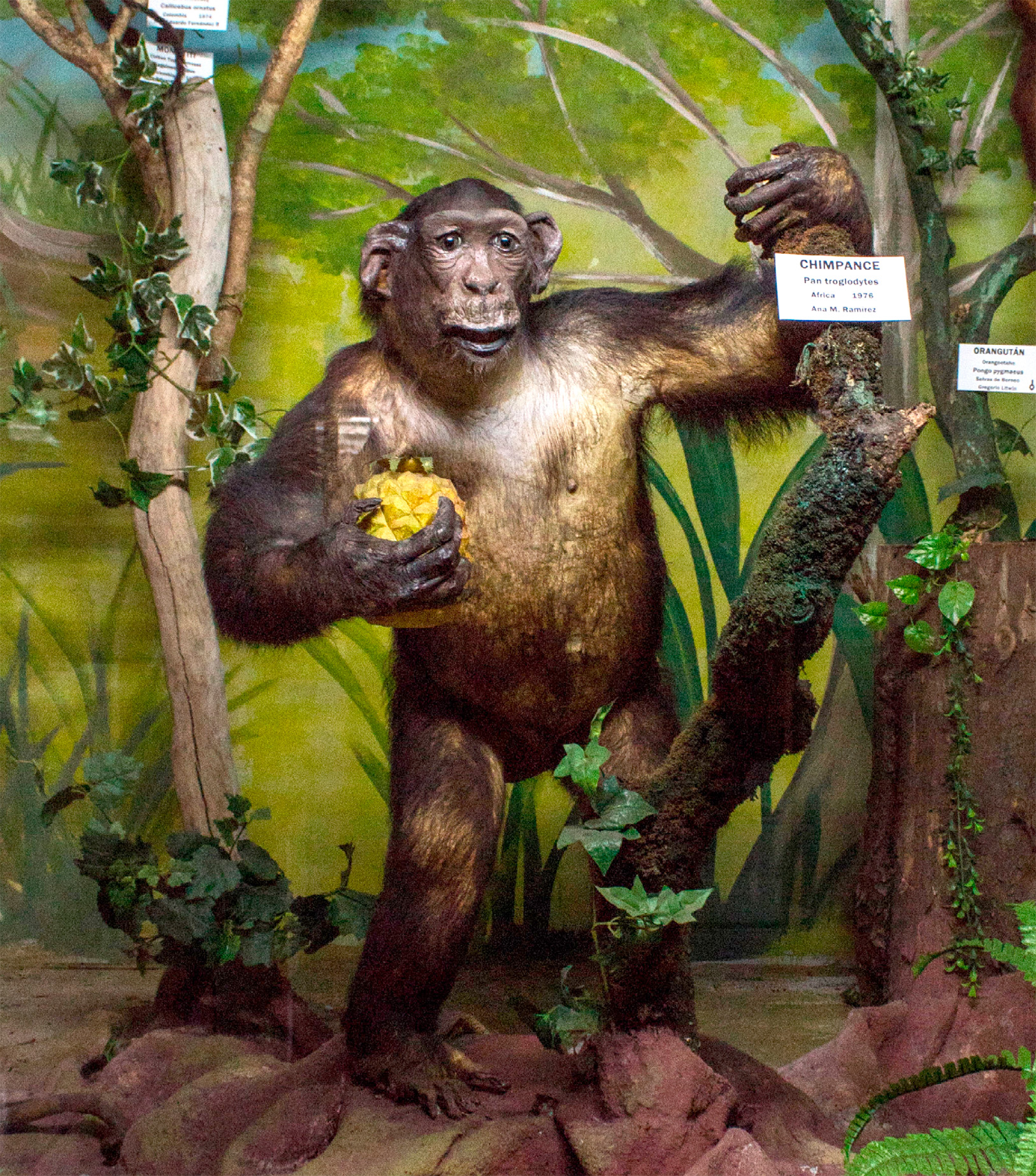
t Museo de Ciencias Naturales

